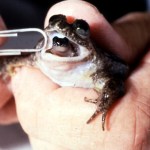Science
Chemistry songs.
Well, there is the classic:
Lehrer's Song of the Elements
but it turns out there is a pageful of them
actually, "Sound of Stirring" is kinda catchy.
"Hello test tube my old friend,
I've come to work with you again
Upon a straight alkane I was keeping
I tried to turn it into a diene
But the two reactants
That I used were oh so wrong
Spent all day long
With just the sound... of stirring"
youtube people!
Get it out there.
The Quantum Control of Light and Matter program is underway here at KITP and I'm sitting in on some of the talks.
with Keto-Eno-Tautomerie-Blues!
Auf Deutsch...
All I can say is, bloomin' heck, some interesting stuff that can be done now.
Not just moving atoms and entanglng qbits, but robust control of nuclear spin ensembles
I missed the Quantum Control by Laser Pulses by Manz and Barth (video, podcast, slides)
but I made it to
Glaser's "NMR Control Overview" (video, podcast)
it is a very long talk, but worth it for the end, where they show robust control of an ensemble of nuclear spins…
Most distant gamma ray burst yet found by Swift.
GRB 090423 at z=8.2
Official NASA Press Release
GRB 090423 click to embiggen
Just as an FYI, Sheril at the Intersection has created this extremely helpful list of policy fellowships for scientists and engineers. It's definitely worth bookmarking if you have any interest in exploring science policy. The fellowships on this list range from weeks to years, and placements are available throughout the federal government, in science agencies and on the Hill.
Yesterday, EurekAlert served up a press release titled New blow for dinosaur-killing asteroid theory, reporting on Gerta Keller of Princeton, who says that the Chicxulub crater isn't really from the asteroid impact that killed the dinosaurs. Keller thinks the crater had nothing to do with the extinction event, and claims to have found evidence that the impact was as much as 300,000 years before the dinosaurs died out.
One or two of the quotes in the piece sounded kind of snotty for a scientific report, but I marked this down as something to look at later. Later in the day, Ethan "Nitro"…
Birth of the Gastric Brooding Frog
Photo Mike Tyler
Unfortunately, species are the ultimate bioephemera.
Amphibians in particular have been declining at an alarming rate over the past several decades; some estimates suggest that a third of amphibian species are on the verge of extinction. My latest essay for SEED's website opens with the story of the Gastric Brooding Frog, Rheobatrachus silus, an extremely peculiar species. It was discovered in the 1970s, and already believed extinct just over a decade later. That's barely enough time to describe a species, much less save it.
Save the Frogs…
I'd like to interrupt the ongoing discussion of how we're in the early chapters of The Stand for a quick question about what really matters: the cute behaviors of my dog.
There's probably a technical term for that thing dogs do where their back legs twitch when you scratch them in just the right spot. I'm not sure what it would be, though-- Kate and I tend to use "reflex arc" as a shorthand, but when I was a kid it was described to me as the equivalent of tickling a dog, so I tend to think of it that way.
Anyway, we give Emmy Advantix as a flea and tick preventative, which works really well.…
summary of the issues and stakes in the current 'flu outbreak from a more theoretical physics perspective...
Three years ago I did a Back of the Envelope Assessment for Bird 'flu:
"...So, why worry?
As always, because of the low probability, high risk scenario.
Taken at face value, there is a ~ 1/100 risk of a pandemic killing ~ 1 billion people worldwide and tens of millions in the US; this is no higher than the "mean risk" of a pandemic of ~ 1/1000 per year, even though I take the prior that we know of a probable impending pandemic with H5N1. So I'd call it a conservative estimate, with…
Posted to EvolDir:
We are getting a new science building and one of the features will be beautiful floor to 3-story ceiling glass panels depicting various (somewhat abstract) images from science. I am looking for high resolution pictures of butterfly wing spots, close-ups of animal eyes, close-ups of feathers, or close-ups of color patterns on your favorite creature (we have plenty of plant images). If you can send me an image or a website address and PERMISSION to use these photos, I would be grateful!
Sincerely,
Amy McMillan, Ph.D, Buffalo State College (mcmillam@buffalostate.edu)
The president spoke to the NAS today, and he made some great promises: increases in funding for science and science education, an investment in training new teachers in science and math, a political commitment to get better advising in science untainted by ideology. He specifically promised 3% of the GDP to go to research in science and technology.
Listen to it in an NAS podcast, or read the transcript. It's a good speech, except for the very last line, which was incredibly stupid…but I'll overlook it as a mindless platitude.
The Kavli Institute has a new piece of kinetic art which has captured the attention of many of the locals...
Jean-Pierre, Kavli Institute artist in residence a cofounder of the algorists, recently put up a lovely piece at the bottom of the staircase at my end of the Institute.
It makes geometric patterns in sand, ever changing.
Some start off simple
but they move.
It is endlessly fascinating, the kids love it (sometimes a bit too much, but the patterns regenerate) and it has kept a number of physicists distracted while they try to figure out how he does it.
(I have a theory, based on…
Back in the stone ages, when I was a student and walked uphill through the snow to class, if you wanted assistance on a homework assignment, you needed to track the instructor of the class down in person, either by going to their posted office hours, or calling them on the phone to set up an appointment. With the introduction of modern communications technology, it is now possible to interact with your instructor electronically, and get help on your homework at times when you couldn't hope to meet them in person.
While this is a tremendous improvement over the old way of doing things, here…
tags: The Beagle Project, science, fund-raising, humor, streaming video
This strange and amusing streaming video features a self-described "fat, bearded chap with a Charles Darwin fixation" whom I know in real life, has an important purpose: Let's help build the HMS Beagle and follow Darwin's journey of discovery! [1:06]
The Beagle Project aims to celebrate Charles Darwin's 200th birthday by building a sailing replica of the HMS Beagle and recreating the Voyage of the Beagle with an international crew of researchers, aspiring scientists and science communicators (perhaps, including me!). The…
tags: Birdbooker Report, bird books, animal books, natural history books, ecology books
"How does one distinguish a truly civilized nation from an aggregation of
barbarians? That is easy. A civilized country produces much good bird
literature."
--Edgar Kincaid
The Birdbooker Report is a special weekly report of a wide variety of science, nature and behavior books that currently are, or soon will be available for purchase. This report is written by one of my Seattle birding pals and book collector, Ian "Birdbooker" Paulsen, and is edited by me and published here for your information and…
Pogonomyrmex micans, Santiago del Estero, Argentina
Ants of the genus Pogonomyrmex ("Pogos") are known to myrmecologists as the classic harvester ants of North American deserts. They are conspicuous insects, the most noticeable of the desert ants, and something of a model organism for studies of ecology. Numerous scientific papers on pogos are published each year, and one species- Pogonomyrmex californicus- is mailed to school classrooms around the country to populate those plastic ant farms.
It's easy to forget amidst the celebrated riches of North American pogos that South…
Christmas greeting card, school unknown, circa 1920.
Dittrick Medical History Center
from Dissection: Photographs of a Rite of Passage in American Medicine 1880-1930
Slate has an intriguing new review by Barron Lerner of a book called Dissection: Photographs of a Rite of Passage in American Medicine 1880-1930, by John Harley Warner and James M. Edmonson. The book delves into the turn-of-the-century practice of photographing medical students with cadavers - photos that today read as weird, grotesque, even offensive.
The photos unearthed by Warner and Edmonson depict an astonishing variety of…
This is an excellent talk by Andy Thomson on the biological and psychological origins of religion.
It's also precisely my position on the matter. There are many people who argue that religion provides a direct evolutionary advantage — I find them unconvincing. Thomson is explaining how religion's origin is indirect, as a byproduct of properties of the brain that we find useful in modeling our world and social interactions…and religion is a parasite that hijacks these traits to promote a caricature of these properties.
(via Richard Dawkins)
Suppose you have a religion and are interested in science. Do you
a. Have to give up your religion
b. Have to abandon your effort to find out about the natural world through science
c. Try to find some accommodation?
Now suppose you are a member of a scientific body, and want to suggest to members of religions that they can be part of the scientific enterprise. What do you do?
a. Tell them they can do so only if they abandon their religion
b. Tell them they cannot be part of the scientific enterprise
c. Tell them that some religions have no apparent problem accommodating science?
According to…
swine 'flu epidemic
passing ship
creation of oil
and other defining moments
all right, serious shit link edition:
Effect Measure is all over the swine 'flu outbreak in SoCal and Mexico
Revere is not prone to panic:
----
PPS: Saturday Night Weird Story Edition
- Read it and ponder.
----
Unusual 'flu cases in SoCal...
The CDC heads-up advisory the CDC has swine 'flu on its front page now, but has gone to normal "steady on chaps" mode
Swine 'flu store evolving
Oh crap! Many cases in Mexico City with multiple fatalities
Swine 'flu update
Another update from Revere
End of the day wrap up…
There was a rally in LA for a group in favor of animal experimentation, Pro-Test, which also had a counter-rally by animal rights groups. You can guess which side I'm on in this debate: blocking experimentation on animals would kill biological research dead. The tactics of the anti-vivisectionists are also reprehensible and deserving of condemnation.
The Pro-Test group, an offshoot of an Oxford, England-based group founded in 2006, was organized by J. David Jentsch, a UCLA neuroscientist who was the target of a recent attack by anonymous animal-rights activists. In the attack, Jentsch's…

